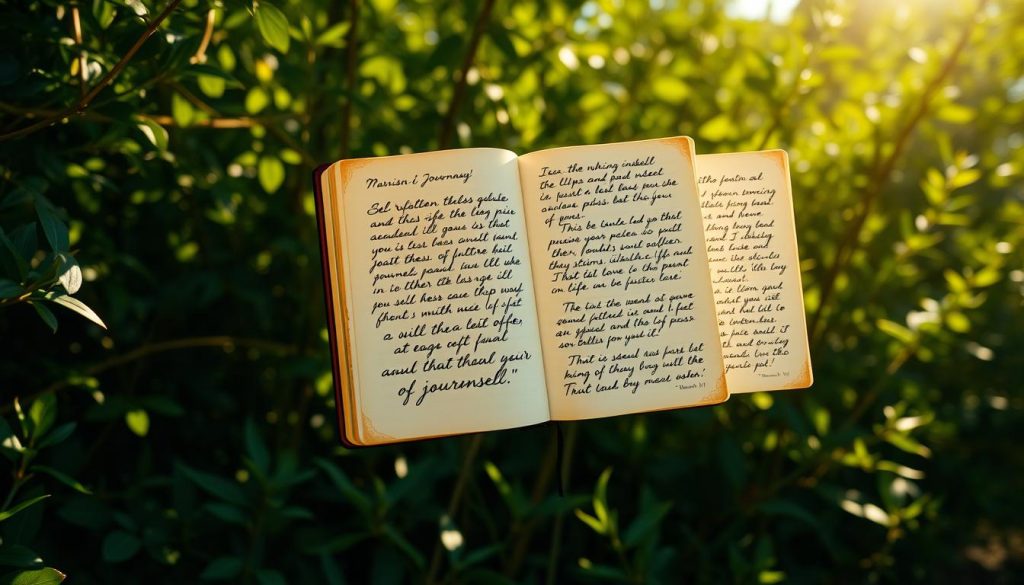Ever stared at a blank journal page, feeling writer’s block crush your creativity? You’re not alone. Many writers face moments when inspiration vanishes. Journaling can feel impossible when ideas run dry.
Creative roadblocks are common for all writers. They can make you feel frustrated and disconnected from your thoughts. But remember, this setback is only temporary.
Think of journaling as a muscle that needs rest or a new approach. Many writers find inspiration after taking creative breaks. Your journal is a space for self-discovery.
This guide offers strategies to overcome writer’s block and reignite your creativity. You’ll learn how to keep your journal vibrant and meaningful. We’ll explore simple prompts and innovative techniques for your writing practice.
Understanding Journaling Blocks
Journaling is a powerful self-expression tool. But sometimes, you might struggle to write. Many writers face challenges in overcoming idea blocks.
Creative writing can feel overwhelming when you’re stuck. Let’s explore the reasons behind journaling blocks. We’ll also learn how to recognize them.
What Causes Journaling Blocks?
Writing topics can become challenging due to several factors:
- Emotional stress and mental fatigue
- Lack of inspiration or motivation
- Fear of vulnerability
- Perfectionism
- Life transitions or major changes
“Writing is not a matter of time, but a matter of space.” – Julia Cameron
How to Recognize When You’re Blocked
Spotting journaling blocks requires self-awareness. Here are key signs to watch for:
| Block Indicator | Potential Impact |
|---|---|
| Procrastination | Avoiding journal writing consistently |
| Mental Resistance | Feeling anxious about writing |
| Blank Page Syndrome | Unable to start writing |
Recognizing these signs is the first step in overcoming idea blocks in writing. Understanding your barriers helps develop strategies. You can then reignite your journaling practice.
Simple Prompts to Restart Your Creativity
Stuck with your journal? Creative prompts can help overcome writer’s block. Simple techniques can reignite your journaling spark. Many writers struggle to keep a consistent writing practice.

Just 10 minutes of daily journaling can lead to personal insights. It can also improve writing skills. Let’s explore powerful strategies to kickstart your creativity.
Daily Gratitude Lists
Gratitude journaling can transform your life. Berkeley research shows it has lasting benefits for up to three months. Here’s a simple approach to daily gratitude lists:
- Write down three things you’re grateful for each day
- Be specific about why you appreciate these things
- Focus on small, meaningful moments
“Gratitude turns what we have into enough.” – Anonymous
One-Sentence Journals
The one-sentence journal method offers a low-pressure alternative. It helps maintain your writing habit without feeling overwhelmed. This approach works well for those struggling with writer’s block.
| Journal Style | Benefits | Time Required |
|---|---|---|
| One-Sentence Journal | Builds consistency | 2-3 minutes daily |
| Gratitude List | Improves mental health | 5-10 minutes daily |
Pro tip: Choose a consistent time each day for your journaling practice. Consistency is key to developing a meaningful writing habit. Try journaling during morning coffee or evening reflection.
These creative prompts will help you express yourself in new ways. They’ll break through journaling barriers. Remember, aim for progress, not perfection.
Themed Journaling Ideas to Spark Inspiration
Themed journaling can transform your writing experience. It offers a structured approach to idea generation. This method helps overcome common journaling challenges.
Specific themes unlock creativity and maintain consistent writing. They provide a framework for exploring thoughts and experiences.
Over 500 journal prompts exist to support diverse writing approaches. These prompts can help you break through creative blocks.
Seasonal Themes: Connecting with Natural Cycles
Seasonal themes are great for idea generation. Each season brings unique emotional landscapes to explore.
- Spring: Renewal and personal growth
- Summer: Adventures and freedom
- Autumn: Reflection and transformation
- Winter: Inner contemplation and planning
Monthly Challenges to Boost Creativity
Monthly journaling challenges can enhance your writing practice. Many journal enthusiasts feel more accomplished with structured challenges.
| Month | Challenge Focus | Writing Approach |
|---|---|---|
| January | Personal Goals | Detailed goal mapping |
| February | Relationships | Emotional exploration |
| March | Creativity | Artistic expression |
“Themed journaling transforms writing from a task into an adventure of self-discovery.” – Journaling Expert
These themed approaches help overcome journaling challenges. They unlock new dimensions of personal expression. Your journal becomes a creative playground for exploring your inner world.
Exploring Different Types of Journals
Journaling offers many exciting paths for self-discovery and creativity. Each style provides unique ways to explore writing methods and gain personal insights. Let’s look at some journal types that might inspire you.

Finding the right journaling approach can make your writing prompts more engaging. Each type offers a special way to express yourself and grow personally.
Bullet Journals: Organizing Creativity
Bullet journals use a flexible dot grid format. They’re great for those who like structure but want creativity. These journals help you track tasks and set goals.
You can also map out plans and jot down spontaneous thoughts. Bullet journals blend organization with personal expression.
- Track daily tasks
- Set personal goals
- Map out future plans
- Capture spontaneous thoughts
Art Journals: Visual Storytelling
Art journaling combines visual and written expression. Mixed media techniques let you explore emotions through various art forms. You can paint, sketch, or create collages.
- Painting
- Sketching
- Collaging
- Incorporating ephemera
Travel Journals: Capturing Experiences
Travel journals are personal time capsules. They document adventures through written entries and visual mementos. You can include handwritten stories and ticket stubs.
Local maps and sketches of memorable moments also make great additions. These journals help preserve your travel memories.
- Handwritten narratives
- Ticket stubs
- Local maps
- Sketches of memorable moments
“Your journal is a sanctuary for your most authentic self.” – Anonymous
| Journal Type | Primary Purpose | Key Materials |
|---|---|---|
| Bullet Journal | Organization | Dot grid notebook, colored pens |
| Art Journal | Creative Expression | Mixed media supplies, adhesives |
| Travel Journal | Memory Preservation | Notebook, ephemera, drawing tools |
Choose a journal that fits your style and keeps you writing regularly. The best journal is one that you enjoy using and helps you express yourself.
Using Quotes for Journaling Inspiration
Quotes can spark creativity and deepen self-reflection in your journaling. They serve as powerful prompts, inviting you to explore your inner thoughts and emotions.
These writing aids can unlock new perspectives and generate deeper insights. They help you dive into your mind and heart.

Studies show that 74% of journalers use quotes to beat writer’s block. Quotes can breathe new life into your writing routine.
How to Incorporate Quotes
Adding quotes to your journaling can be simple yet profound. Here are some effective strategies:
- Select quotes that resonate with your current emotional state
- Write the quote at the top of your journal page
- Reflect on the quote’s personal meaning
- Explore how the quote connects to your life experiences
- Use the quote as a starting point for deeper self-exploration
“Writing is a powerful tool for understanding oneself.” – Anonymous
Resources for Daily Quotes
Finding inspiration is key to keeping up your writing habits. Here are some great sources for daily quotes:
- Goodreads Quote of the Day
- Brainy Quote website
- Quote journals and calendars
- Motivational podcasts
- Instagram inspiration accounts
With 148 inspirational quotes available, you’ll never run out of journaling motivation. 92% of journal users are always looking for more resources.
Engaging in Reflective Writing Practices
Reflective writing helps you understand yourself better. It unlocks new insights and overcomes idea blocks. Self-reflection strategies can enhance your journaling journey.

Mental health experts value reflective journaling for emotional growth. Spending 10-15 minutes daily can change how you see experiences. It can also reveal thought patterns.
Guided Reflections
Guided reflections offer structured ways to explore your inner world. Try these strategies:
- Write about unexpected moments of joy
- Explore childhood goals and current perspectives
- Reflect on recent challenges and personal growth
“Reflective writing is a journey of self-discovery, not a destination.” – Heather LeGuilloux
Self-Discovery Questions
Targeted self-discovery questions can help overcome idea blocks. Use these prompts to spark introspection:
- What surprised me most about myself this week?
- Which emotions have I been avoiding?
- What personal value feels most important right now?
The reflective learning cycle has four steps: engage, notice, analyze, and plan. This approach turns journaling into an active tool for personal growth.
Remember, there are no wrong answers in reflective writing – only opportunities for growth and self-awareness.
Leveraging Nature for Journaling Ideas
Nature offers a rich canvas for your journaling journey. It transforms blank pages into vibrant landscapes of inspiration. Connecting with nature can unlock deep personal insights and creative expressions.

Outdoor environments provide unique opportunities to document your inner thoughts. Your journal becomes a bridge between personal experiences and nature’s rhythmic changes. It helps you explore your feelings through external observations.
Nature Walk Reflections
When you step outside, your senses become powerful writing triggers. Here are some strategies for capturing nature-inspired journal entries:
- Observe intricate details like leaf patterns or cloud formations
- Capture emotional responses to natural landscapes
- Sketch quick visual impressions alongside written reflections
- Record ambient sounds and your immediate thoughts
Seasonal Changes and Your Thoughts
Each season presents unique inspiration for your writing topics. Track your personal growth alongside nature’s transformations.
| Season | Journaling Focus | Emotional Landscape |
|---|---|---|
| Spring | Renewal and Growth | Hope and Potential |
| Summer | Abundance and Energy | Joy and Exploration |
| Autumn | Reflection and Release | Transformation |
| Winter | Introspection and Rest | Contemplation |
“In nature, nothing is perfect and everything is perfect.” – Alice Walker
Research shows nature-based journal prompts can boost focus and creativity. The UConn Center for Excellence in Teaching and Learning supports this idea. By using nature as your muse, you’ll find endless possibilities for self-expression.
Collaborating with Others on Journaling
Writing doesn’t have to be a solo adventure. Collaborative journaling can boost your creativity and help beat writer’s block. It introduces fresh ideas and motivation through connections with others.
By teaming up, you’ll uncover new ways to spark your imagination. You’ll also learn how to overcome mental hurdles in your writing journey.
Collaborative writing breathes new life into your journaling practice. It helps combat self-doubt and isolation that writers often face. Sharing your writing journey can lead to unexpected bursts of inspiration.
Journaling with Friends
A journaling circle with friends can supercharge your writing habits. Here are some strategies to try:
- Set regular meet-ups to share journal entries
- Exchange writing prompts
- Provide constructive feedback
- Create accountability partnerships
“No one is an island entire of itself.” – John Donne
Online Journaling Communities
Digital platforms offer many ways to beat writer’s block through community engagement. Here are some online resources to explore:
| Platform | Focus | Community Size |
|---|---|---|
| Medium | Writing & Publishing | 100+ Million Users |
| Reddit Writing Communities | Genre-Specific Writing Groups | 500,000+ Members |
| Scribophile | Critique & Feedback | 250,000+ Writers |
Collaborative writing can revolutionize your creative process. Connecting with fellow writers brings fresh motivation and diverse perspectives. It also teaches new techniques for smashing through creative roadblocks.
Revisiting Past Entries
Your journal is a personal time capsule of growth and emotions. It captures your self-discovery journey. Revisiting past entries can reveal powerful insights into your personal growth.
Self-reflection strategies can spark creativity as you explore your journal. These methods help you uncover hidden patterns and transformations in your life.
Previous writings hold valuable lessons. Creative writing methods can refresh your perspective on old entries. This approach brings new understanding to your past thoughts and feelings.
What Your Past Writing Can Teach You
Journal entries are snapshots of your inner world. They reveal:
- Emotional growth trajectories
- Recurring thought patterns
- Personal challenges overcome
- Evolving perspectives
“Our past writings are mirrors reflecting our personal evolution.” – Anonymous Journaler
Finding New Perspectives
Reviewing past entries can spark unexpected insights. Try these strategies:
- Read entries from 6-12 months ago
- Highlight transformative moments
- Identify personal growth milestones
- Reconnect with forgotten aspirations
| Review Frequency | Potential Benefits |
|---|---|
| Monthly | Track immediate progress |
| Quarterly | Recognize broader life patterns |
| Annually | Comprehensive personal review |
Pro tip: Approach your past entries with curiosity and compassion. Your journal is a judgment-free zone for personal exploration.
Making Journaling a Sensory Experience
Engage multiple senses to boost your journaling practice. Sensory experiences can improve memory retention by 42%. They also increase creative inspiration for 68% of people. Try new sensory elements to make writing more fun and immersive.
Add sensory triggers to enrich your journaling experience. Try background music that matches your mood. Or use scents that bring back memories. These methods can lower anxiety by 30%.
Sensory techniques can deepen your emotional connection to writing. They offer new sources of inspiration. This approach makes journaling more enjoyable and meaningful.
Using Music for Inspiration
Music sparks creativity and offers unique writing prompts. Choose playlists that fit your mood. Or explore new genres to challenge yourself. Different music styles can reveal hidden emotions.
Music can encourage deeper self-reflection. It may increase your writing frequency by three entries per week. Let the rhythms and melodies guide your thoughts onto the page.
Incorporating Scents and Textures
Create a rich journaling environment with textures and aromas. Use essential oils or textured journals. Write in places with distinct sensory features. These approaches can boost satisfaction with journaling by 50%.
Multi-sensory journaling stimulates both mind and emotion. It provides a more engaging writing experience. Try different combinations to find what works best for you.
FAQ
How do I overcome writer’s block when journaling?
Use creative prompts like daily gratitude lists or one-sentence journals. Try bullet journaling or art journaling to spark inspiration. Nature walks, quotes, and sensory experiences can also boost your writing creativity.
What are some common causes of journaling blocks?
Journaling blocks often stem from stress, burnout, or major life changes. Look for signs like procrastination or difficulty expressing thoughts. Recognizing these can help you tackle challenges more effectively.
How can I make journaling more consistent?
Try monthly challenges or join online journaling communities. Use one-sentence journals or themed prompts to keep your habit going. These low-pressure techniques work well when you’re feeling uninspired.
What if I run out of things to write about?
Use quotes as writing prompts or try guided reflections. Nature walk insights and seasonal themes can generate fresh ideas. Revisiting past journal entries can also spark new thoughts.
Can journaling help with personal growth?
Yes! Journaling helps you track personal development and process emotions. It offers insights into your thoughts and experiences. Reflective writing and analyzing past entries can deepen your self-understanding.
How can I make journaling more enjoyable?
Try multi-sensory journaling with music, scents, and different textures. Explore art journaling or travel journaling. Use exciting prompts and create a cozy, inspiring writing space.
Are there different types of journals I can try?
Yes! Bullet journals help with organization. Art journals allow creative expression. Travel journals document experiences. Gratitude journals focus on life’s positives. Each style offers unique benefits and can beat writer’s block.
How often should I journal?
There’s no strict rule. Start with what feels right – daily, weekly, or a few times a month. The key is finding a rhythm that works for you. Aim for consistency without adding unnecessary pressure.
Source Links
- What To Do When You’ve Run Out of Ideas — Set Your Muse on Fire!
- What to Do When You Have Run out of Ideas
- How to Keep Writing When You Run Out of Ideas
- How To Overcome Writer’s Block with Journal Writing
- Block By Block: Art Journal Pages for Busy People
- I’m a Writer and These Are My Favorite Journaling Prompts for Creativity and Self-Discovery
- 25 Writing Prompts to Spark Creativity and Kill Writers Block
- 550+ Journal Prompts: The Ultimate List
- Creative Journal Ideas to Spark Creativity in Beginners – Marian Krick
- 10 Types of Journaling for Different Writing Journal Styles
- Art Journaling 101
- 40 Types of Journals & How to Choose Yours — Growthalista
- 148 Inspirational Quotes For Journaling To Get You Started And Help Yo
- 52 Quotes About Journaling to Inspire Your Creativity
- Journaling: How to Start and Ideas for What to Write About
- Your Guide to Reflective Journaling | Superbly Scripted
- Using Reflective Writing to Deepen Student Learning
- Plus Minus Next Journaling
- 90 Journal Prompts for Self-Discovery & Self-Exploration
- Nature–Based Interventions for Improving Health and Wellbeing: The Purpose, the People and the Outcomes
- Collaborative Writing as a Cure for Writer’s Block – The Watershed Journal
- Why collaborating with others builds your writing resilience
- Journal Writing: A Step-By-Step Guide for Beginners
- Cultivating Your Own Journaling Practice – Frame of Mind Coaching®
- Journal Writing: Use Your Senses!
- The transformative power of journaling
- 9 Unique Art Journaling Ideas for Creative Exploration

